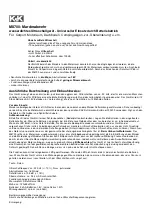
7.
Install the bolt finger-tight.
8.
Repeat steps
through
for each side
adjustment.
9.
Torque all 3 bolts to 41 N∙m (30 ft-lb). Always
tighten the front bolt first.
Note:
Adjustments of more than 3.8 cm (1-1/2
inches) may require temporary assembly to an
intermediate height to prevent binding (e.g.,
changing from 3.1 to 7 cm (1-1/4 to 2-3/4 inches)
height of cut).
Checking the Interlock
Switches
Service Interval:
Before each use or daily
CAUTION
If safety interlock switches are disconnected
or damaged, the machine could operate
unexpectedly, causing personal injury.
•
Do not tamper with the interlock switches.
•
Check the operation of the interlock
switches daily and replace any damaged
switches before operating the machine.
The interlock switches are designed to shut off the
machine when you rise from the seat when the
traction pedal is pressed. However, you may rise from
the seat while the engine is running and the traction
pedal is in the N
EUTRAL
position. Although the engine
continues to run when you disengage the PTO switch
and release the traction pedal, shut off the engine
before rising from the seat.
1.
Park the machine on a level surface, engage the
parking brake, lower the cutting units, and turn
the key to the O
FF
position.
2.
Press the traction pedal and turn the key to the
O
N
position.
Note:
If the engine cranks, there is a
malfunction in the interlock system. Correct this
malfunction before operating the machine.
3.
Turn the key to the O
N
position, rise from the
seat, and move the PTO switch to O
N
.
Note:
The PTO should not engage. If the
PTO engages, there is a malfunction in the
interlock system. Correct this malfunction before
operating the machine.
4.
Engage the parking brake, turn the key to the
O
N
position and move the traction pedal out of
the N
EUTRAL
position.
Note:
The InfoCenter displays "traction denied"
and the machine should not move. If the
machine does move, there is a malfunction in
the interlock system. Correct this malfunction
before operating the machine.
Checking the
Blade-Stopping Time
Service Interval:
Before each use or daily
Note:
Lower the cutting units onto a clean section of
turf or hard surface to avoid throwing dust and debris.
To verify this stopping time, have someone stand back
from the cutting units at least 6 m (20 ft) and watch the
blades on 1 of the cutting units. Disengage the PTO
and record the time it takes for the blades to come to
a complete stop. If this time is greater than 7 seconds,
adjust the braking valve. Call your authorized Toro
distributor for assistance in making this adjustment.
Selecting a Blade
Standard Combination Sail
This blade provides excellent lift and dispersion in
almost any condition. If you require more or less lift
and discharge velocity, consider a different blade.
Attributes: Excellent lift and dispersion in most
conditions.
Angled Sail
This blade generally performs best in lower heights of
cut—1.9 to 6.4 cm (3/4 to 2-1/2 inches).
Attributes:
•
Discharge remains more even at lower heights of
cut.
•
Discharge has less tendency to throw left and
thus leaves a cleaner look around bunkers and
fairways.
•
Lower power is required at lower heights and
dense turf.
28
















































